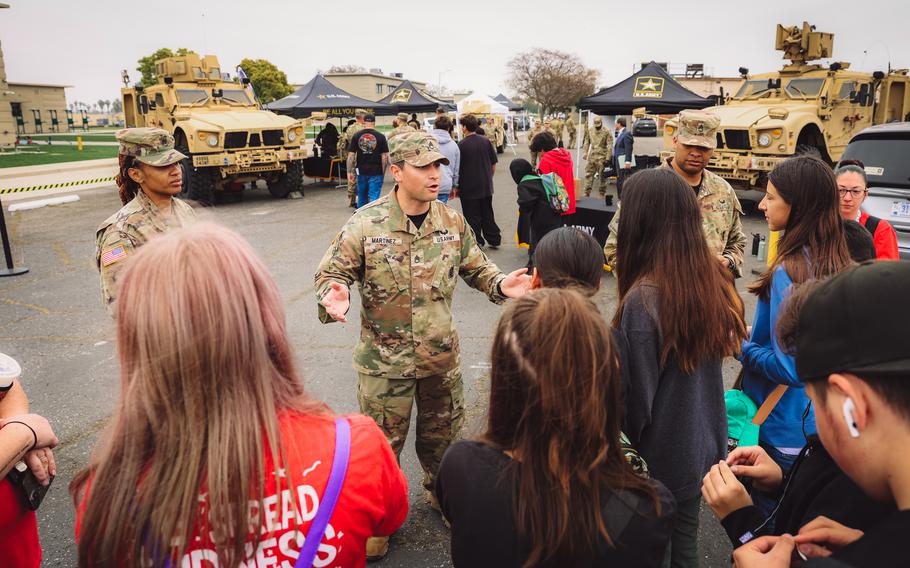
Army Staff Sgt. Brandon Martinez with the Fontana Army Recruiting Company welcomes students at a “Meet Your Army” event at Joint Forces Training Base Los Alamitos, Calif., on April 22, 2024. (Brandon Hernandez/U.S. Army Reserve)
The Army will send 25 noncommissioned officers to work with civilian organizations for four months to learn innovations in recruiting to help improve the service’s new training and lay the groundwork for new strategies in attracting more recruits across the country.
Five companies — Amazon, Deloitte, Wells Fargo, the University of Louisville and Boot Camp Digital — will host the soldiers through December as part of a years-long process to overhaul how the Army finds and enlists new soldiers, Army Recruiting Command announced Monday.
“We believe that there are some modernized techniques and functionalities out there that we’re just not privy to yet,” said Sgt. Maj. Alan Myers, the top enlisted soldier for the Army’s Directorate of Military Personnel Management, Acquire and Retain Division.
The NCOs are part of a new job created last year by the Army — a talent acquisition specialist, or 42T. Soldiers can apply to transfer to the new occupational specialty and must pass through a strenuous selection process. For years, the Army has involuntarily selected soldiers to work temporarily in recruiting as part of career development.
To be selected, soldiers must have the right attributes that fit what a successful recruiter looks like, said Col. Christine Rice, the officer in charge of the workforce redesign for developing the talent acquisition specialists.
This first group of 25 NCOs were chosen from a group of 113 applicants, she said.
Sgt. 1st Class Reychell Zuniga Otoya, a recruiter since 2020, said she applied to be one of the Army’s first talent acquisition specialists because she loves the job. She’s been leading a recruiting station in her hometown of Miami, but later this month, she’ll join Wells Fargo as part of the training program.
“I truly believe there is no better employer than the United States Army,” she said. “This was my chance to be a part of that innovation, and that’s why I went this route, and I’m very happy I did.”
Creating a new job and training with outside organizations is part of an effort announced in October by the Army to pull out of a recruiting slump that emerged following the coronavirus pandemic. While the Army is on track to meet enlistment goals for this fiscal year, which ends Sept. 30, it missed its goals the two previous years.
During the pandemic, recruiters lost access to high schools, which are a main resource for finding new soldiers. Bouncing back from a recruiting dip was difficult for every military branch, particularly because young people’s interest in enlisting has dropped over time.
Rice said learning from civilian organizations can help the Army adapt to prospective soldiers’ preferences that might not include visiting recruiters at a physical location and how that varies in different areas of the country.
“Can we do things more virtually? Can we actually go out and engage the population on their terms?” she asked. “It’s being able to look at what success looks like from other businesses that are successful in a region, take that and apply it to how we operate in the future.”
Throughout the four months, soldiers will be tasked with learning about several topics including branding techniques, marketing, digital prospecting, social media, onboarding processes, recruiting strategies and planning.
Eventually the old way of selecting and training recruiters will fade out and all recruiting will be conducted by these talent acquisition specialists, but that is years away, Rice said. Right now, the Army has roughly 8,000 recruiting personnel but hopes to lower that through efficiencies found in this process, she said.
After the civilian training program ends, the NCOs will have to complete additional Army training, Myers said. Then 15 of the NCOs will train a new group of talent acquisition specialists and the rest will go to recruiting stations throughout the country to begin implementing what they’ve learned.
“This is definitely a marathon. This is not a sprint,” Rice said. “It’s going to require a lot of experimentation, a great amount of creativity and adaptability to an ever-evolving operational environment that we’re in right now and in the future.”